Split Injection GC: Increasing Response Factors for Compounds Prone to Inlet Liner Adsorption by Using Shoot-and-Dilute GC
“Practical GC” provides readers with practical advice and new experimental evidence for how to get the best results from their gas chromatography (GC) systems. The next instalment looks at the potential for reducing inlet adsorption of active compounds through the use of split injection GC.
Photo Credit: Ralf Hiemisch/Getty Images

Jack Cochran, Restek Corporation, Bellefonte, Pennsylvania, USA.
“Practical GC” provides readers with practical advice and new experimental evidence for how to get the best results from their gas chromatography (GC) systems. The next instalment looks at the potential for reducing inlet adsorption of active compounds through the use of split injection GC.
Hopefully, by now at least, readers who are following this Practical GC series on split injection gas chromatography (GC) (1–3) have been able to take advantage of its benefits in their own laboratories. Chemists analyzing environmental samples, especially those that produce dirty extracts, could have the most to gain from split injection GC given the wide variety of semivolatile organic compounds that are typically determined. Analyte lists include compounds that can react with GC inlet liner surfaces during splitless injection, leading to degradation of those compounds, which prohibits their accurate quantification. In fact, an example was given in my first Practical GC article in The Column (1) for the pesticides endrin and DDT. Sample extracts containing high concentrations of involatile material exacerbate the situation because the nonvolatiles are deposited on the inlet liner wool and bottom seal where they catalyze degradation of sensitive compounds. Buildup of nonvolatile material in the inlet during repeated splitless injections leads to even higher breakdown. Split injection mitigates the degradation potential because the typical inlet flow is 10 times (or more) higher than for splitless injection. The time for unwanted reactions on liner surfaces, including those that have been modified by nonvolatile coextractives, is reduced in split injection.
While dealing with reactive compounds that degrade in the GC inlet is bad enough, environmental sample analysts have another (more?) insidious enemy: the tendency of so-called “active” compounds to tenaciously adsorb to GC inlet liner and column surfaces, which leads to peak tailing, poor sensitivity, and sometimes, complete loss of compound response. These active compounds include the general classes of acids and bases, while specific difficult analytes are 2,4-dinitrophenol, pentachlorophenol, and benzidine. Adsorption of active compounds during splitless injection is characterized by lower and lower response factors (RFs) as decreasing amounts of compound (that is, lower concentrations) are injected. This leads to high percentage relative standard deviations (% RSDs) for average response factors (Avg RFs), nonâlinear calibration curves, and, potentially, inaccurate quantification. Here too, for active compound analysis, split injection could offer some assistance with its short inlet residence time - that is, faster compound transfer time from GC inlet to column. Opportunity for more efficient introduction of active analyte to the GC column is one benefit, but split injection also lowers the amount of nonvolatile material transferred to the GC column when analyzing dirty samples. That nonvolatile material on the front of the GC column is an adsorptive “stationary phase” that causes severe peak tailing for active compounds. When this happens the only way to restore performance is to completely cut out the contaminated length of the column, which shortens column lifetime by eventually compromising separations of critical compounds.
Since gas chromatographers prefer to avoid peak tailing, inaccurate quantification, downtime for inlet and column maintenance, and short column lifetimes, this instalment of Practical GC will demonstrate the potential for reducing inlet adsorption of active compounds, in this case, phenols, through the use of split injection.
Experimental
A 30 m × 0.25 mm, 0.25-µm Rtx-5MS GC column (Restek) with helium carrier gas at a constant flow of 2.0 mL/min was operated with the following GC oven programme: 40 °C (1.5 min), 15 °C/min to 250 °C. A flame ionization detector (FID - Agilent) at 340 °C on a GC (Agilent 6890) was used with nitrogen makeup and column flow at 50 mL/min. Fast autosampler injections of standards (1 µL) containing a select group of phenols in dichloromethane at 200 ng/µL, 100 ng/µL, 50 ng/µL, 20 ng/µL, 10 ng/µL, 5 ng/µL, 2 ng/µL, and 1 ng/µL each compound were made into a 4-mm precision-type inlet liner with deactivated quartz wool for split GC at 250 °C. The split ratio was 10. Based on the split ratio, the following on-column amounts were expected for each phenol: 18.2 ng, 9.09 ng, 4.55 ng, 1.82 ng, 0.909 ng, 0.455 ng, 0.182 ng, and 0.0909 ng. For splitless GC, standards were prepared in dichloromethane at 18.2 ng/µL, 9.09 ng/µL, 4.55 ng/µL, 1.82 ng/µL, 0.909 ng/µL, 0.455 ng/µL, 0.182 ng/µL, and 0.0909 ng/µL such that 1 µL splitless injections would put the same amounts on-column as the split injections assuming transfer efficiencies were the same for each injection type. For splitless injection, a 4-mm single taper inlet liner with deactivated quartz wool was used at a temperature of 250 °C and the splitless valve time was 1.4 min, allowing a 2x sweep of the inlet liner with carrier gas before the split valve was opened to remove any remaining solvent.
Results and Discussion
Comparing RFs for split and splitless injection is one way to determine transfer efficiency from inlet to column for active, less volatile phenols. Figure 1 indicates that splitless injection gives lower RFs than split injection for phenols for what should be the same on-column amounts, suggesting incomplete transfer from the splitless inlet before the split (purge) valve was opened, possibly through adsorption on liner wool. Adsorption of phenols during splitless injection is exacerbated in several ways, including: (a) loss to glass wool (even fresh, well-deactivated quartz wool), (b) slow inlet flow for splitless injection (~1.5 mL/min splitless vs. 22 mL/min split in this work), (c) lower temperature for point of transfer (wool in the splitless liner is at the bottom, which is a cooler temperature zone in many GC inlets, especially with a lower GC oven initial temperature, versus the higher-placed wool in the precisionâtype split liner), and (d) coâinjected, nonvolatile “dirt” from sample extracts.
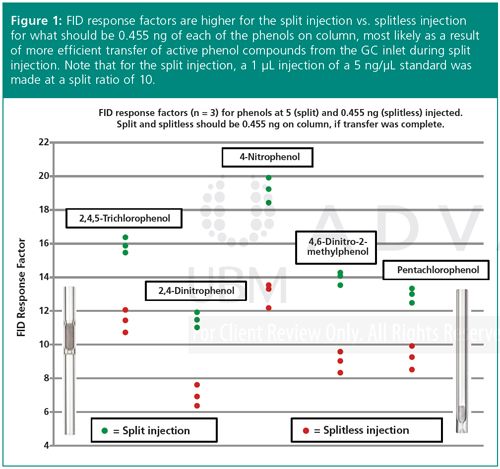
It was mentioned above that sample coâextractives can lead to loss of response for active compounds in splitless injection, but that is not always the case. In fact, food pesticide chemists using GC know that a high concentration of sugars and other hydroxyârich compounds in extracts can actually have an “analyte protectant” effect to improve inlet transfer (and thus, response) of active pesticides, especially when those pesticides are at lower levels (4). This often leads to the use of “matrixâmatched” calibration standards instead of solvent-only standards, or the addition of sugars and other volatile compounds to all standards and extracts to improve GC performance for certain pesticides. While adding “analyte protectants” to extracts may or may not be an option for environmental analysts, having a higher concentration of phenols injected generally leads to higher RFs in splitless GC. This means that the RF comparison in Figure 1 could be skewed in favour of split since 5 ng was injected versus the 0.455 ng injected for splitless. Figure 2 demonstrates RFs for 5 ng and 4.55 ng of each phenol injected, split and splitless, respectively, which now means there should be 0.455 ng on-column for split and 4.55 ng on-column for splitless. While RFs did indeed increase slightly for 2,4-dinitrophenol and 4,6-dinitro-2-methylphenol for the 4.55 ng (Figure 2) versus 0.455 ng splitless injections (Figure 1), phenol RFs are still better overall for split injection, suggesting a more complete transfer to the GC column during split injection.
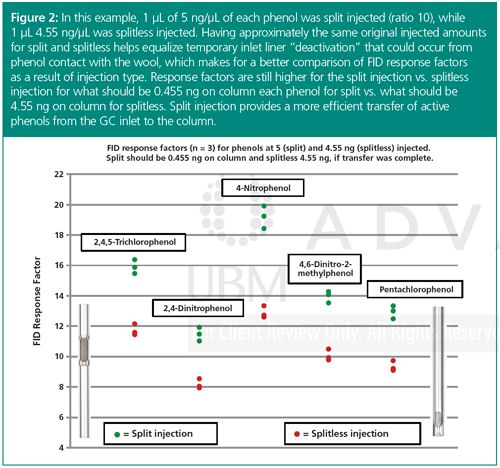
While the focus so far in this article has been on the less volatile phenols, even those that are smaller and elute earlier in the gas chromatogram can show discrimination in splitless vs. split injection - probably as a result of their adsorption in the inlet liner. Table 1 lists Avg RFs and % RSDs for both split and splitless injection for a broader group of phenols ranging from what should be 0.0909 ng to 18.2 ng amounts on the GC column for each injection type. For every compound, the split injection shows a higher Avg RF and lower % RSD, suggesting that more reliable quantification could be achieved through split injection. Although not shown here, the correlation coefficients for multipoint calibration curves ranging from 0.0909 ng to 18.2 ng on-column were also better for split vs. splitless injection. Relative percent difference (RPD) between split and splitless Avg RF indicates a general trend towards lower response factors as phenol volatility decreases; this is not surprising given that lower volatility active compounds are more prone to adsorption on surfaces.
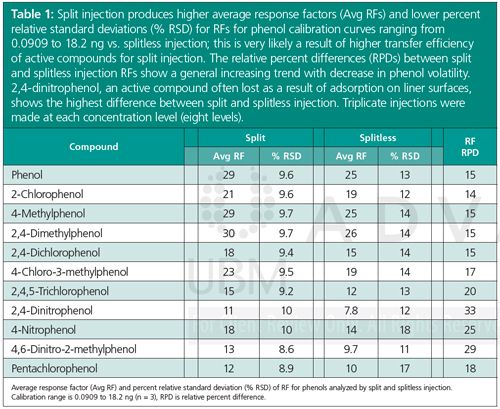
Two of the biggest benefits of shootâandâdilute GC (split injection GC) are increased GC column uptime and increased GC column lifetime, both of which occur because of a decrease in the amount of nonvolatile co-extracted material that gets onto the GC column from dirty sample extracts. However, split injection can put greater demands on initial GC column inertness; otherwise, the lower amounts of active compounds can exhibit peak tailing or even outright loss, as a result of column adsorption effects. In the work presented here, that was not a problem and even subâng levels of phenols could be determined with good peak shapes (Figure 3).
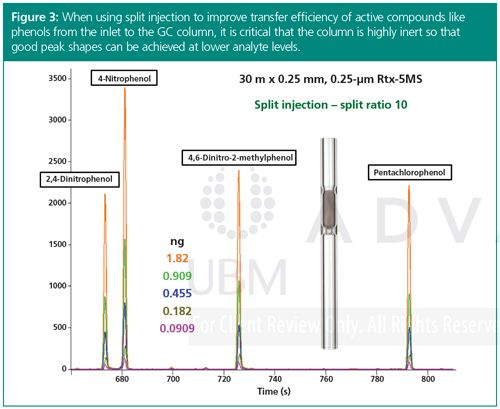
I work with many environmental analysts who, in response to dirty, complex sample extracts that can overload and contaminate GC columns, employ extract dilution and splitless injection (diluteâandâshoot GC). However, given the advantages offered by the high inlet flow of split injection, which leads to a short inlet residence time that reduces degradation and adsorption for tricky compounds, they would be much better off trying split injection, that is, “shootâand-dilute” GC, instead.
Conclusions
Split injection with a precision-type inlet liner and higher inlet flow enhances the transfer of active/adsorptive compounds like phenols from GC inlet to GC column to improve accuracy and repeatability of analysis. When used for the analysis of dirty environmental sample extracts, split injection puts less nonvolatile material on the front of the GC column versus splitless injection, which leads to better activeâcompound peak shapes and increased GC column uptime and lifetime.
References
- Jack Cochran, The Column 11(21), 14 (2015).
- Jack Cochran, The Column 12(4), 10 (2016).
- Jack Cochran, The Column 12(8), 10 (2016).
- Michelangelo Anastassiades, Katerina Mastovska, and Steven J. Lehotay, Journal of Chromatography A1015, 163–184 (2003).
Jack Cochran is a Director of New Business and Technology at Restek Corporation. He is a recognized expert in GC and GC–GC for the analysis of pesticides and priority pollutants. He serves on the Board of Directors for FLAG Works (sponsor of NACRW) and the Centre of Oil and Gas Research and Development at the University of Manitoba. Jack is also an Adjunct Professor in the Forensic Science Programme at The Pennsylvania State University.
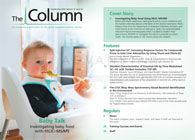
Common Challenges in Nitrosamine Analysis: An LCGC International Peer Exchange
April 15th 2025A recent roundtable discussion featuring Aloka Srinivasan of Raaha, Mayank Bhanti of the United States Pharmacopeia (USP), and Amber Burch of Purisys discussed the challenges surrounding nitrosamine analysis in pharmaceuticals.
Extracting Estrogenic Hormones Using Rotating Disk and Modified Clays
April 14th 2025University of Caldas and University of Chile researchers extracted estrogenic hormones from wastewater samples using rotating disk sorption extraction. After extraction, the concentrated analytes were measured using liquid chromatography coupled with photodiode array detection (HPLC-PDA).











